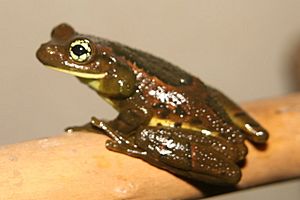Rio golden-eyed tree frog facts for kids
Quick facts for kids Rio golden-eyed tree frog |
|
|---|---|
 |
|
| Conservation status | |
| Scientific classification |
The Rio golden-eyed tree frog (Trachycephalus imitatrix) is a fascinating type of frog that lives in the warm, wet forests of Argentina and Brazil. It belongs to the Hylidae family, which includes many kinds of tree frogs. This frog is special because of its bright, golden eyes!
These frogs make their homes in different kinds of forests. You can find them in subtropical or tropical lowland forests, which are usually very green and full of life. They also live in subtropical or tropical moist montane forests, which are found on mountainsides and are often covered in mist. Sometimes, they even live near freshwater marshes, which are wet, grassy areas.
Sadly, the Rio golden-eyed tree frog is currently facing a threat: its habitat is slowly disappearing. This is mainly due to human activities like cutting down forests. Scientists are working to understand and protect these amazing creatures.
Contents
What is a Rio Golden-Eyed Tree Frog?
The Rio golden-eyed tree frog is a small amphibian, meaning it can live both on land and in water. Like other tree frogs, it has special pads on its toes that help it climb trees and stick to leaves. This allows it to live high up in the forest canopy, away from many dangers on the ground.
Where Do These Frogs Live?
These frogs are native to South America. They are found in two main countries:
- Brazil: Especially in the southeastern parts, where there are large areas of rainforest.
- Argentina: In the northeastern regions, which also have warm, humid climates perfect for frogs.
Their preferred homes are places with lots of moisture and dense plant life. This includes:
- Lowland rainforests: These are forests close to sea level, known for their tall trees and heavy rainfall.
- Mountain forests: Forests found on hills and mountains, where the air is often cooler and misty.
- Freshwater marshes: Wet areas with shallow water and lots of plants, perfect for breeding.
Life Cycle of the Rio Golden-Eyed Tree Frog
Like most frogs, the Rio golden-eyed tree frog goes through several stages in its life. This process is called metamorphosis.
Reproduction and Eggs
When it's time to lay eggs, female frogs usually find a safe, wet spot. This might be near a pond, a slow-moving stream, or even in a temporary pool of water that forms after rain. The eggs are typically laid in clumps or strings.
Tadpoles and Growth
After the eggs hatch, tiny creatures called tadpoles emerge. Tadpoles live completely in the water. They look more like small fish than frogs, with a tail for swimming and gills for breathing underwater. They feed on algae and other tiny plant matter. As they grow, their bodies start to change. They develop hind legs first, then front legs. Their tails gradually get shorter, and their gills are replaced by lungs, allowing them to breathe air.
Young Frogs and Adults
Once the tadpole's tail has almost disappeared, it becomes a young frog, sometimes called a froglet. At this stage, it can leave the water and start living on land, though it still needs to stay moist. As it grows into an adult, it will develop its full size and colors, including those distinctive golden eyes. Adult frogs primarily eat insects and other small invertebrates.
Threats to the Rio Golden-Eyed Tree Frog
The biggest danger to the Rio golden-eyed tree frog is the loss of its natural home. This is often called habitat loss.
Why Habitat Loss Happens
- Deforestation: Forests are cut down for farming, cattle ranching, or to make space for towns and cities. This removes the trees and plants that frogs need for shelter and food.
- Pollution: Water sources can become polluted by chemicals from farms or industries. This harms the frogs and their food sources.
- Climate Change: Changes in weather patterns, like longer dry seasons or more intense storms, can affect the wet environments these frogs rely on.
When their habitat disappears, these frogs have fewer places to live, find food, and reproduce. This makes it harder for their populations to survive and thrive. Protecting their rainforest homes is very important for the future of the Rio golden-eyed tree frog and many other amazing animals.
Images for kids
See also
 In Spanish: Trachycephalus imitatrix para niños
In Spanish: Trachycephalus imitatrix para niños



